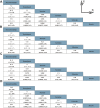Comparison of Five Prophylactically Intravenous Drugs in Preventing Opioid-Induced Cough: A Bayesian Network Meta-Analysis of Randomized Controlled Trials
- PMID: 34867314
- PMCID: PMC8635493
- DOI: 10.3389/fphar.2021.684276
Comparison of Five Prophylactically Intravenous Drugs in Preventing Opioid-Induced Cough: A Bayesian Network Meta-Analysis of Randomized Controlled Trials
Abstract
Background: Due to the absence of direct comparisons of different therapeutic drugs in preventing opioid-induced cough (OIC) during the induction of general anesthesia, clinicians often faced difficulties in choosing the optimal drug for these patients. Hence, this network meta-analysis was conducted to solve this problem. Methods: Online databases, including Pubmed, Embase, Web of Science, Cochrane, and Google Scholar, were searched comprehensively to identify eligible randomized controlled trials (RCTs), up to March 15th, 2021. Within a Bayesian framework, network meta-analysis was performed by the "gemtc" version 0.8.2 package of R-3.4.0 software, and a pooled risk ratio (RR) associated with 95% credible interval (CrI) was calculated. Results: A total of 20 RCTs were finally enrolled, and the overall heterogeneity for this study was low to moderate. Traditional pair-wise meta-analysis results indicated that all of the five drugs, namely, lidocaine, ketamine, dezocine, butorphanol, and dexmedetomidine could prevent OIC for four clinical outcomes, compared with the placebo (all p-values < 0.05). Moreover, dezocine had the best effect, compared with that of the other drugs (all p-values < 0.05). Network meta-analysis results suggested that the top three rank probabilities for four clinical outcomes from best to worst were dezocine, butorphanol, and ketamine based on individual/cumulative rank plots and surface under the cumulative ranking curve (SUCRA) probabilities. The node-splitting method indicated the consistency of the direct and indirect evidence. Conclusions: Our results indicated that all of these five drugs could prevent OIC compared with the placebo. Moreover, the top three rank probabilities for four clinical outcomes from best to worst were dezocine, butorphanol, and ketamine. Our results were anticipated to provide references for guiding clinical research, and further high-quality RCTs were required to verify our findings. Systematic Review Registration: [https://www.crd.york.ac.uk/prospero/], identifier [CRD42021243358].
Keywords: drugs; network meta-analysis; opioid-induced cough; pharmacological interventions; randomized controlled trials.
Copyright © 2021 Dong and Chang.
Conflict of interest statement
The authors declare that the research was conducted in the absence of any commercial or financial relationships that could be construed as a potential conflict of interest.
Figures








Similar articles
-
A Bayesian network meta-analysis of non-pharmacological interventions for neonatal pain management: a clinical effectiveness comparison.Front Pediatr. 2025 May 22;13:1547308. doi: 10.3389/fped.2025.1547308. eCollection 2025. Front Pediatr. 2025. PMID: 40475220 Free PMC article.
-
Effectiveness Comparisons of Drug Therapy on Chronic Subdural Hematoma Recurrence: A Bayesian Network Meta-Analysis and Systematic Review.Front Pharmacol. 2022 Mar 17;13:845386. doi: 10.3389/fphar.2022.845386. eCollection 2022. Front Pharmacol. 2022. PMID: 35401183 Free PMC article.
-
Efficacy of dezocine on preventing opioid-induced cough during general anaesthesia induction: a PRISMA-compliant systematic review and meta-analysis.BMJ Open. 2022 Apr 4;12(4):e052142. doi: 10.1136/bmjopen-2021-052142. BMJ Open. 2022. PMID: 35379614 Free PMC article.
-
Different interventions in preventing opioid-induced cough: a meta-analysis.J Clin Anesth. 2016 Nov;34:440-7. doi: 10.1016/j.jclinane.2016.05.034. Epub 2016 Jun 17. J Clin Anesth. 2016. PMID: 27687431 Review.
-
Dezocine prevents sufentanil-induced cough during general anesthesia induction: a meta-analysis of randomised controlled trials.BMC Anesthesiol. 2020 Jun 22;20(1):154. doi: 10.1186/s12871-020-01076-w. BMC Anesthesiol. 2020. PMID: 32571219 Free PMC article.
Cited by
-
Effect of pretreatment with a small dose of esketamine on sufentanil-induced cough during anesthesia induction: a randomized controlled trial.BMC Anesthesiol. 2024 Mar 26;24(1):116. doi: 10.1186/s12871-024-02501-0. BMC Anesthesiol. 2024. PMID: 38528479 Free PMC article. Clinical Trial.
-
Effects of Dezocine on the Reduction of Emergence Delirium after Laparoscopic Surgery: A Retrospective Propensity Score-Matched Cohort Study.J Pers Med. 2023 Mar 28;13(4):590. doi: 10.3390/jpm13040590. J Pers Med. 2023. PMID: 37108976 Free PMC article.
-
Efficacy and safety of ketamine and esketamine for preventing opioid-induced cough: a systematic review and meta-analysis of randomized controlled trials.Syst Rev. 2025 Jul 1;14(1):131. doi: 10.1186/s13643-025-02886-0. Syst Rev. 2025. PMID: 40598615 Free PMC article.
-
A Comparison of the Effects of Sevoflurane, Propofol, and Propofol Combined with Butorphanol in Suppressing Sufentanil-Induced cough-A Randomized Controlled Trial.Drug Des Devel Ther. 2025 Feb 25;19:1347-1355. doi: 10.2147/DDDT.S492641. eCollection 2025. Drug Des Devel Ther. 2025. PMID: 40026335 Free PMC article. Clinical Trial.
-
Efficacy of dexamethasone pretreatment on prevention of opioid-induced cough during anesthetic induction: A trial-sequential meta-analysis.Medicine (Baltimore). 2025 Jun 13;104(24):e42860. doi: 10.1097/MD.0000000000042860. Medicine (Baltimore). 2025. PMID: 40527846 Free PMC article.
References
-
- Ando K., Akimoto K., Sato H., Manabe R., Kishino Y., Homma T., et al. (2020). Brigatinib and Alectinib for ALK Rearrangement-Positive Advanced Non-small Cell Lung Cancer with or without Central Nervous System Metastasis: A cSystematic Review and Network Meta-Analysis. Cancers (Basel) 12 (4). 10.3390/cancers12040942 - DOI - PMC - PubMed
-
- Bang S. R., Ahn H. J., Kim H. J., Kim G. H., Kim J. A., Yang M., et al. (2010). Comparison of the Effectiveness of Lidocaine and Salbutamol on Coughing Provoked by Intravenous Remifentanil during Anesthesia Induction. Korean J. Anesthesiol 59 (5), 319–322. 10.4097/kjae.2010.59.5.319 - DOI - PMC - PubMed
Publication types
LinkOut - more resources
Full Text Sources

